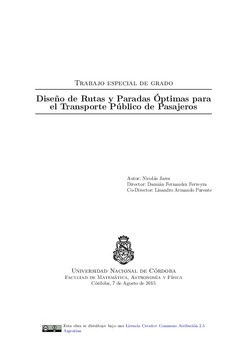| dc.contributor.advisor | Fernández Ferreyra, Damián Roberto | |
| dc.contributor.advisor | Parente, Lisandro Armando | |
| dc.contributor.author | Jares, Nicolás | |
| dc.date.accessioned | 2016-06-22T14:58:22Z | |
| dc.date.available | 2016-06-22T14:58:22Z | |
| dc.date.issued | 2015-08-07 | |
| dc.identifier.citation | Bibliografía: p. 72 | |
| dc.identifier.uri | http://hdl.handle.net/11086/2730 | |
| dc.description | Tesis (Lic. en Ciencias de la Computación)--Universidad Nacional de Córdoba, Facultad de Matemática, Astronomía, Física y Computación, 2015. | es |
| dc.description.abstract | En este trabajo se estudia el problema de diseñar una nueva línea de colectivo para un sistema de transporte urbano masivo de pasajeros dado, con el objetivo de mejorar la eficiencia total del sistema. Para ello se considera el grafo de las calles de una ciudad y las líneas ya existentes. Se generan algunas rutas posibles entre algunos pares origen-destino mediante una estategia de búsqueda que combina el algoritmo de busqueda A* y el algoritmo de Búsqueda en Profundidad (Deep First Search). Se utiliza un modelo de afectación de tráfico para determinar el equilibrio de usuario de Wardrop. Este último se escribe como un problema de optimización de una función cóncava sobre un conjunto convexo, el cual es resuelto con el método de gradiente proyectado.
Para realizar el presente trabajo se utilizaron datos reales de un sector de la ciudad de Córdoba: algunas de sus calles y las líneas de colectivos existentes a la fecha. En particular se intentó mejorar la eficiencia del sistema con respecto al acceso a las dependencias de la Universidad Nacional de Córdoba. | es |
| dc.description.abstract | In this work the problem of designing a new bus line for a given system of mass urban passenger transport, with the aim of improving the overall system efficiency, is studied. For that is considered the graph of the streets of a city and its existing lines. Some possible routes between some source-destination pairs are generated by a search strategy that combines the A* search algorithm and Deep First Search. A model of traffic affectation is used to determine the Wardrop user balance. The latter is written as an optimization problem of a concave function on a convex set, which is solved with the projected gradient method.
To make this work, real data from a sector of the city of Cordoba were used: some of its streets and existing lines at the date. In particular it sought to improve the efficiency of the system with respect to access to the offices of the Universidad Nacional de Córdoba. | en |
| dc.language.iso | spa | es |
| dc.rights | Creative Commons Atribución 2.5 Argentina | |
| dc.rights.uri | http://creativecommons.org/licenses/by/2.5/ar/ | |
| dc.subject | Traffic problem | es |
| dc.subject | Operations research, mathematical programming. Applications of mathematical programming | es |
| dc.subject.other | Problemas de asignación de tráfico | |
| dc.subject.other | Optimización no lineal | |
| dc.subject.other | Traffic assignment problems | en |
| dc.subject.other | Non linear optimization | en |
| dc.title | Diseño de rutas y paradas óptimas para el tranporte público de pasajeros | es |
| dc.type | bachelorThesis | es |





